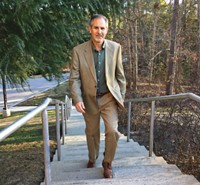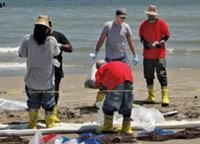Advertisement
Grab your lab coat. Let's get started
Welcome!
Welcome!
Create an account below to get 6 C&EN articles per month, receive newsletters and more - all free.
It seems this is your first time logging in online. Please enter the following information to continue.
As an ACS member you automatically get access to this site. All we need is few more details to create your reading experience.
Not you? Sign in with a different account.
Not you? Sign in with a different account.
ERROR 1
ERROR 1
ERROR 2
ERROR 2
ERROR 2
ERROR 2
ERROR 2
Password and Confirm password must match.
If you have an ACS member number, please enter it here so we can link this account to your membership. (optional)
ERROR 2
ACS values your privacy. By submitting your information, you are gaining access to C&EN and subscribing to our weekly newsletter. We use the information you provide to make your reading experience better, and we will never sell your data to third party members.
Environment
Inside the institute charged with exploring how chemicals affect human health
Fifty-year-old National Institute of Environmental Health Sciences is the U.S.’s top environmental health research agency
by Britt E. Erickson
September 26, 2016
| A version of this story appeared in
Volume 94, Issue 38
NIEHS at a glance
Year established: 1966
Location: 375-acre campus in Research Triangle Park, N.C.
Budget: about $775 million
Number of full-time employees: 662
Number of extramural grants awarded annually: more than 1,000
Note: Numbers are for fiscal 2016
North Carolina was facing tough economic times in the early 1960s. “The agriculture industry was slowing down, textile and cotton mills were shutting down, and tobacco factories were closing,” says John Schelp, a community outreach specialist at the National Institute of Environmental Health Sciences (NIEHS). Even North Carolina’s famous furniture industry was having problems, Schelp says. “Students would go to college in North Carolina and, as quickly as possible, leave the state to get jobs elsewhere.”
But the state’s fortunes began to turn after then-Gov. Terry Sanford (D) announced in January 1965 that a new environmental health division of the National Institutes of Health was coming to North Carolina’s Research Triangle Park (RTP). Then, six weeks later, IBM announced it too was setting up shop in RTP.
Fast forward fifty years and today RTP, located in north central North Carolina, is thriving as one of the largest research and development parks in the world. NIEHS is an integral part of it.
NIH established its environmental health division in RTP in 1966, with a budget of $70 million. By 1969, environmental health was becoming a biomedical research priority for the U.S. In that year, the division was elevated to institute status and renamed NIEHS. It is the only NIH institute located wholly outside of Maryland.
Today, the institute has an annual budget of about $775 million. More than 70% of its money goes to support R&D contracts and research grants awarded to the external scientific community. The remaining funds support 662 intramural researchers and administrative staff who work on the 375-acre NIEHS campus in RTP.
NIEHS is best known for supporting research linking chemical exposures to health effects. In 1972, the institute funded work that provided the first evidence that exposure to lead, even at low levels, can lower a child’s IQ (Nature 1972, DOI: 10.1038/235111a0). Later NIEHS-funded studies linked exposure to the metal with behavioral and neurological disorders. The research ultimately led the U.S. to ban lead in household paint in 1978 and to phase out lead in gasoline over 23 years starting in 1973.
In other notable work, NIEHS researchers in 1975 found an association between a mother’s exposure to diethylstilbestrol, a synthetic estrogen, and cancer in her offspring, as well as other health disorders that could be passed down to future generations (J. Reprod. Med. 1975, 15, 29). The drug was prescribed to pregnant women to prevent miscarriages and preterm births from 1938 until 1971.
More recently, NIEHS has funded research into the potential health effects of endocrine disrupting chemicals such as phthalates used in shampoos, flame retardants in upholstered furniture, and bisphenol A in cash register receipts.
NIEHS has focused much effort on respiratory health throughout its history. Institute-supported work found an association between exposure to asbestos and lung tumors in 1967 (JAMA, J. Am. Med. Assoc. 1967, DOI: 10.1001/jama.1967.03130080029007). NIEHS funded research that linked secondhand smoke to respiratory effects and, ultimately, lung cancer in 1985.
In the early 1990s, the NIEHS-funded Harvard Six Cities Study linked exposure to fine particles in air pollution in a half-dozen U.S. cities with mortality, even when air quality was within federal standards (N. Engl. J. Med. 1993, DOI: 10.1056/nejm199312093292401). The findings ultimately led to tighter Clean Air Act regulation of fine particle pollution.
NIEHS’s focus on pulmonary effects continues to this day. For example, the institute is supporting research to better understand how exposure to air pollution, including soot, leads to asthma.
Congress handed new responsibility to NIEHS in 1987, directing the institute to oversee work on the toxic effects of chemicals tainting Superfund hazardous waste sites. As they oversee the remediation of hazardous waste, federal agencies need scientific evidence on hazard and exposure to determine the degree of cleanup needed. In other words, they need to know “how clean is clean,” says Gwen Collman, director of NIEHS’s extramural division.
NIEHS supports 17 Superfund research centers at universities across the country. These centers examine the human health effects of chemicals and chemical mixtures in Superfund sites. The institute also trains people who will clean up Superfund sites, giving workers “a greater understanding of the hazardous substances they will be handling,” Collman adds.
Major accomplishments
Unraveling basic cellular pathways and mechanisms that can lead to disease
▸ Former NIEHS director Martin Rodbell shared Nobel Prize in Physiology or Medicine in 1994 for discovery of G-proteins.
Funding policy-changing research that has improved public health
▸ Lead exposure linked to lower IQ in children. The finding led EPA to ban lead in household paint and gasoline.
▸ Fine particle air pollution linked to mortality. As a result, EPA updates Clean Air Act regulations.
Protecting people during disasters
▸ NIEHS has supported work to understand the health effects of disasters, such as the Sept. 11, 2001, World Trade Center attack in New York City, Hurricane Katrina in 2005, the Deepwater Horizon Gulf of Mexico oil spill in 2010, Hurricane “Superstorm” Sandy in 2012, and the West Virginia Elk River chemical spill in 2014.
NIEHS is also home of the National Toxicology Program (NTP), a federal interagency effort formed in 1978 to evaluate the safety of chemicals. NTP is best known for its Report on Carcinogens, a list of chemicals that are “known” or “reasonably anticipated” to cause cancer in humans. The list is typically updated every other year.
One of the most controversial of these reports, released in 2011, included formaldehyde and styrene. The chemical industry pushed back, fighting hard for NTP to remove the two substances from the report.
NIEHS director Linda Birnbaum considers that move par for the course.
“If you label something as a human carcinogen, either known or reasonably anticipated, if that is somebody’s product they are not going to be happy. They are going to do everything they can to raise questions about it,” says Birnbaum, who has been leading the institute and NTP since 2009.
The chemical industry challenged the styrene listing in federal court—and lost. Then, at the behest of Congress, the National Academies also examined NTP’s inclusion of styrene and formaldehyde in the carcinogen report—and concluded that the actions were justified.
NTP remains in the forefront of controversies over chemical hazards. It is conducting research on the herbicide glyphosate, best known as the active ingredient in Monsanto’s Roundup. Last year, the World Health Organization’s International Agency for Research on Cancer declared that the chemical is probably carcinogenic.
“The real question,” Birnbaum says, is “not so much about glyphosate itself, but about commercial formulations.” Glyphosate is typically mixed with inert ingredients that have not been thoroughly studied for their toxicity. Some formulations “don’t have any effects,” Birnbaum says. “Some have loads of effects.” The most toxic formulations aren’t necessarily the ones with the most glyphosate, she adds.
Meanwhile, the biggest challenge facing NIEHS—like all of NIH’s 27 institutes and centers—is a budget that hasn’t kept up with inflation, Birnbaum says. “Our funding is down in our extramural grants. Success rates are way down. That is across much of NIH,” she adds.
The situation becomes acute when emergencies strike, such as the recent outbreaks of Ebola and spread of the Zika virus, Birnbaum notes. To pay for research related to such emergencies, she says, “We usually take the money from somewhere else,” diverting funds from other research priorities.
Despite a lackluster budget, “we have maintained some of our strengths in toxicology, basic biomedical science, and epidemiology,” Birnbaum says. “We also have moved into some new areas, such as examining the health impacts of climate change,” she tells C&EN.
Environmental justice is also important to today’s NIEHS. The agency began exploring the issue under the leadership of Kenneth Olden, the institute’s director from 1991 to 2005.
Olden broadened what NIEHS considers as the environment “to include poverty, socioeconomic status, and environmental justice,” Schelp says. “Where do you think the stinky, smelly, toxic asphalt plants are in Durham? Near the country club or in the poor, less affluent community of color?” he asks. Olden led federal efforts to ensure that environmental injustice—such as the concentration of polluting industries and hazardous waste sites in poor neighborhoods—is a priority for action, Schelp says.
Birnbaum, too, has made environmental justice a priority. She attends two or three community forums each year to learn firsthand about the environmental health issues that low-income and minority communities face.
“You can’t do effective environmental health research unless you engage the people who have the environmental issues,” Birnbaum says. “It is very important to understand what people in communities are concerned about.”
More recently, NIEHS has supported work to understand the health effects of major disasters. In 2001, for instance, the institute responded to the Sept. 11 attacks in New York City. The institute provided money for training cleanup workers, and assessment of their chemical exposures. NIEHS was also on the scene after Hurricane Katrina in 2005, the Deepwater Horizon Gulf of Mexico oil spill in 2010, Superstorm Sandy in 2012, and the chemical spill that tainted the public water supply in the Charleston, W.Va., area in 2014.
Some of those studies are ongoing. For example, NIEHS is continuing to monitor the health of 32,000 people who participated in cleaning up the Gulf of Mexico after the Deepwater Horizon disaster, the largest marine oil spill in U.S. history.
Cleanup crews “used an unprecedented amount of dispersants to try to control where the oil went,” recalls Richard Kwok, an NIEHS staff scientist and lead investigator of the study. Crude oil contains heavy metals, polycyclic aromatic hydrocarbons, and volatile organic compounds such as benzene, a known carcinogen, as well as toluene, and ethylbenzene, he points out.
“When you mix these chemicals in the oil with dispersants, they could become more easily absorbed if an individual comes into contact with this mixture,” he says. “There was concern among the public whether there are any long lasting human health effects from these types of exposures.”
NIEHS launched the Gulf Long-term Follow-up Study (GuLF STUDY) in 2011 to address some of those human health concerns. “A lot of these people weren’t professional cleanup workers,” Kwok notes. “These were unemployed fishermen, college students home for summer break, and people employed in other industries who decided to help clean up their backyard and neighborhoods.”
Epidemiology studies such as the GuLF STUDY tend to make the headlines. Yet the majority of NIEHS researchers are working on projects that are “long-term, high-risk, high-reward, multidisciplinary, and highly collaborative,” says Darryl Zeldin, a senior investigator and scientific director of NIEHS’s intramural research division.
If a research project “can be funded through traditional grant mechanisms, we generally don’t do it,” Zeldin says. “Our vision is to be the premier research organization that seeks to understand how environmental factors influence human health and disease and the mechanisms involved.” The majority of NIEHS scientists are “basic researchers trying to understand molecular mechanisms,” Zeldin says.
Such work may uncover “a brand new signaling pathway, or a new way that environmental factors influence cell or organ function,” Zeldin notes. “Then you can target that pathway for treatment and therapy,” he says. It is impossible to get funding for this type of work elsewhere, he adds.
That type of basic research won former NIEHS researcher Martin Rodbell the 1994 Nobel Prize in Physiology or Medicine. Rodbell shared the prize with Alfred G. Gilman of the University of Texas Southwestern Medical Center for the discovery of G-proteins or guanine nucleotide-binding proteins. These proteins transmit signals between cells and control cellular signaling or the transmission of molecular signals from the outside of a cell to its interior. Rodbell led NIEHS’s signal transduction laboratory from 1989 until he retired in 1994, after serving as the institute’s scientific director between 1985 and 1989.
Advertisement
In addition to funding high-risk, high-reward research, NIEHS’s intramural division also has a major effort in training graduate students and postdoctoral fellows, Zeldin says. “We have an elaborate training process where we prepare people for research careers,” he notes. Trainees are typically postdocs that work at the institute for four to five years, although they can stay as long as eight years. NIEHS now has about 300 postdocs working in its intramural division.
NIEHS officials want to invest more in training the next generation of environmental health researchers, Zeldin says. But over the years, it’s been forced to downsize its intramural program because of a shrinking budget, he adds. At its peak, NIEHS had about 80 principal investigators. Today, that number is about 60.
If NIEHS ever gets more money, Birnbaum knows the research areas to which she wants to direct the funds. For example, “we are just beginning to look at preconception exposure,” she says. “The trajectory of your life is set early, not only in utero and in early childhood.” She adds, “Dads matter,” meaning that what a father is exposed to before conception of his children can affect them.
Other areas for further research that have caught Birnbaum’s eye include chemical mixtures. For example, she’s interested in investigating how viruses such as Zika interact with chemicals such as pesticides and how chemicals and nutrition affect the microbiome.
Exposure to chemicals is also an area of growing research interest. “A major focus has been putting much more emphasis on exposure,” not just hazard, Birnbaum says. Researchers are beginning to “look at the totality of exposures,” rather than just one chemical at a time.
Scientists have learned a great deal in the last half-century about how chemicals in the environment affect human health. Much of that work was supported by NIEHS.
“I believe our country is healthier because of NIEHS research,” Birnbaum says. “When we understand how the environment impacts our health, we can do something about it.”










Join the conversation
Contact the reporter
Submit a Letter to the Editor for publication
Engage with us on Twitter